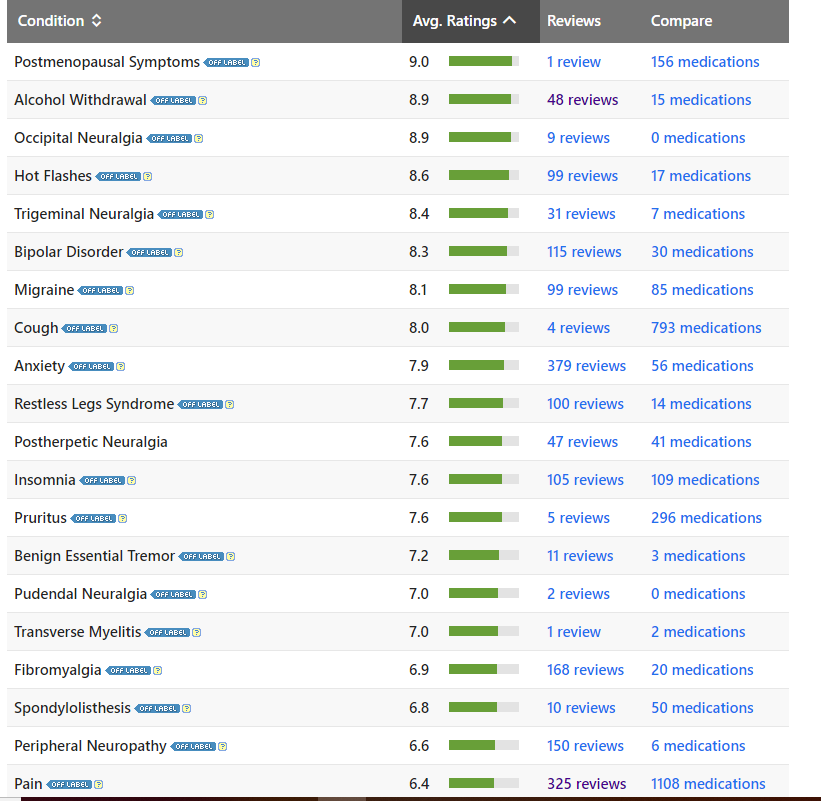All the pharms in our network are us licensed pharmacies and never sell controlled substances. We will send you order ID and tracking ID together within two business days after you placed your orders. But It is beyond our control after I sent you order ID and tracking ID. Please ignore any call from call centers because we never call customers to refill orders. Please follow the refill day limitation to refill your drug and never overdose fioricet generic and gabapentin.
 All Pharmacies associated are licensed to distribute in the states, you can be 100% sure to receive the same quality medication that you get from your local drug store.
All Pharmacies associated are licensed to distribute in the states, you can be 100% sure to receive the same quality medication that you get from your local drug store.
Upon receiving a valid prescription of the product you buy. Our US licensed pharmacies will fill a prescription for a medication that is FDA approved. To assure confidentiality and privacy our US licensed Pharmacy will fill and ship your prescription in a discreet package.
It is beyond our control after I sent you order ID and tracking ID. You can pay us by either COD payment and Credit Card (CC) Payment. We donot collect CC information in this website because it is not secure. You will find our Email address after you submitted your order. We will send you our secure websites to collect your CC information once you have picked up your first COD or CC order.
You must have taken Gabapentin before you buy gabapentin online and you should know what you should know before you buy Gabapentin online. You also should know the side effects of gabapentin. Before you buy Gabapentin online, please be sure you are not listed in What kind of patients are not allowed to buy Gabapentin Online.
We also have a blacklist and yellow list. When you have sent the postman a fraud Money order or ask charge back after you have accepted the prescription, you will be blacklisted immediately and be banned from the whole online pharmacy network. If you do not pick up your order after you clicked “Place Order Now” link, you will be placed into yellow list and it may take longer and harder for you to take your refill.
What is gabapentin?
Gabapentin is an anti-epileptic medication, also called an anticonvulsant. It affects chemicals and nerves in the body that are involved in the cause of seizures and some types of pain. Gabapentin is used in adults to treat nerve pain caused by herpes virus or shingles (herpes zoster).
The Horizant brand of gabapentin is also used to treat restless legs syndrome (RLS). The Neurontin brand of gabapentin is also used to treat seizures in adults and children who are at least 3 years old. Gabapentin is also used to cure migraine. Gabapentin is effective in insomnia. Gabapentin is effective in alleviating itching in renal failure (uremic pruritus) and itching of other etiologies.
Use only the brand and form of gabapentin that your doctor has prescribed. Check your medicine each time you get a refill at the pharmacy, to make sure you have received the correct form of this medication.
Gabapentin was first approved for use in 1993. In the United States it has been available as a generic medication since 2004.
Gabapentin may be useful in the treatment of comorbid anxiety in bipolar patients, (however not the bipolar state itself). Gabapentin may be effective in acquired pendular nystagmus and infantile nystagmus, (but not periodic alternating nystagmus). It is effective in hot flashes. It may be effective in reducing pain and spasticity in multiple sclerosis. Gabapentin may reduce symptoms of alcohol withdrawal (but it does not prevent the associated seizures). Use for smoking cessationhas had mixed results.
Suicide
In 2009 the U.S. Food and Drug Administration issued a warning of an increased risk of depression and suicidal thoughts and behaviors in patients taking gabapentin, along with other anticonvulsant drugs. modifying the packaging insert to reflect this. A 2010 meta analysis confirmed the increased risk of suicide associated with gabapentin use.
Gabapentin Mechanism of action
The mechanism of the anticonvulsant action of gabapentin has not been fully described. Though similar in structure to the endogenous neurotransmitter GABA, gabapentin has not been shown to bind to GABA receptors at concentrations at or below 1 mM. Gabapentin modulates the action of glutamate decarboxylase (GAD) and branched chain aminotransferase (BCAT), two enzymes involved in GABA biosynthesis. In human and rat studies, gabapentin was found to increase GABA biosynthesis, and to increase non-synaptic GABA neurotransmission in vitro.
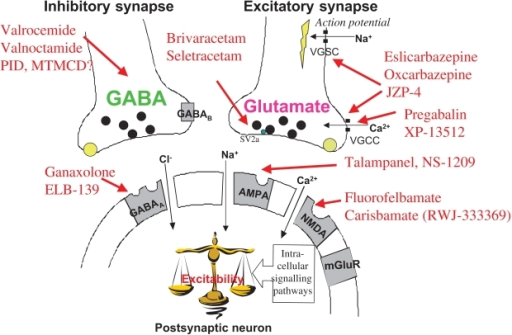
Gabapentin has been shown to bind to the ?2?-1 subunit of voltage gated calcium ion channels which attributes to its pain attenuation effects in diabetic neuropathy and post-herpetic neuralgia. Other neurophysiological findings indicate that gabapentin also interacts with NMDA receptors, protein kinase C, and inflammatory cytokines
HOW TO USE Gabapentin
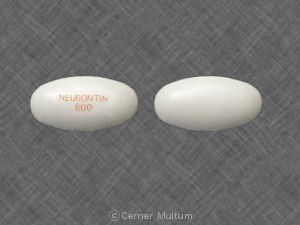 Read the Medication Guide and, if available, the Patient Information Leaflet provided by your pharmacist before you start taking gabapentin and each time you get a refill. If you have any questions, ask your doctor or pharmacist.
Read the Medication Guide and, if available, the Patient Information Leaflet provided by your pharmacist before you start taking gabapentin and each time you get a refill. If you have any questions, ask your doctor or pharmacist.
Take this medication by mouth with or without food as directed by your doctor. Dosage is based on your medical condition and response to treatment. For children, the dosage is also based on weight.
If you are taking the tablets and your doctor directs you to split the tablet in half, take the other half-tablet at your next scheduled dose. Discard half tablets if not used within several days of splitting them. If you are taking the capsules, swallow them whole with plenty of water.
It is very important to follow your doctor’s dosing instructions exactly. During the first few days of treatment, your doctor may gradually increase your dose so your body can adjust to the medication. To minimize side effects, take the very first dose at bedtime.
Take this medication regularly to get the most benefit from it. This drug works best when the amount of medicine in your body is kept at a constant level. Therefore, take gabapentin at evenly spaced intervals at the same time(s) each day. If you are taking this medication 3 times a day to control seizures, do not let more than 12 hours pass between doses because your seizures may increase.
Do not take this medication more often or increase your dose without consulting your doctor. Your condition will not improve any faster and the risk of serious side effects may increase.
Do not stop taking this medication without consulting your doctor. Some conditions may become worse when the drug is suddenly stopped. Your dose may need to be gradually decreased.
Antacids containing aluminum or magnesium may interfere with the absorption of this medication. Therefore, if you are also taking an antacid, it is best to take gabapentin at least 2 hours after taking the antacid.
Different forms of gabapentin (such as immediate-release, sustained-release, enacarbil sustained-release) are absorbed in the body differently. Do not switch from one form to the other without consulting your doctor.
Tell your doctor if your condition does not improve or if it worsens.
What Diseases can Gabapentin be treated ?
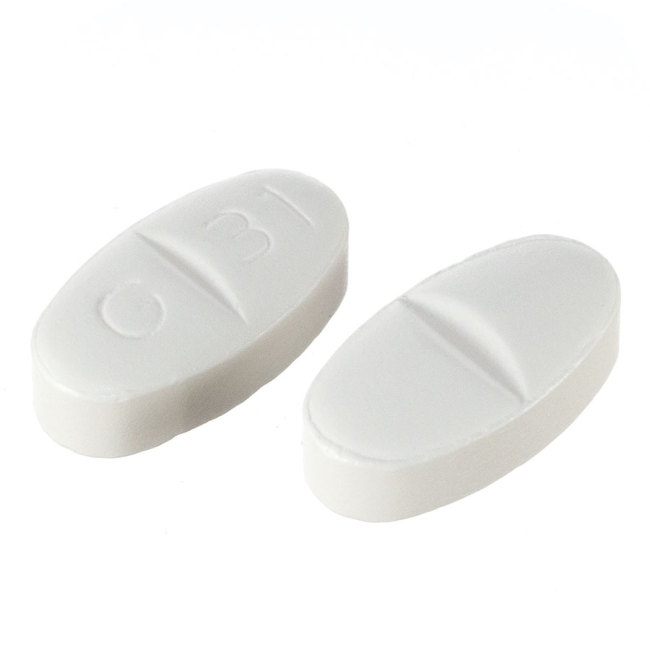
Gabapentin capsules, tablets, and oral solution are used to help control certain types of seizures in people who have epilepsy. Gabapentin capsules, tablets, and oral solution are also used to relieve the pain of postherpetic neuralgia (PHN; the burning, stabbing pain or aches that may last for months or years after an attack of shingles).
Gabapentin extended-release tablets (Horizant) are used to treat restless legs syndrome (RLS; a condition that causes discomfort in the legs and a strong urge to move the legs, especially at night and when sitting or lying down).
Gabapentin is in a class of medications called anticonvulsants. Gabapentin treats seizures by decreasing abnormal excitement in the brain.
Gabapentin relieves the pain of PHN by changing the way the body senses pain. It is not known exactly how gabapentin works to treat restless legs syndrome.
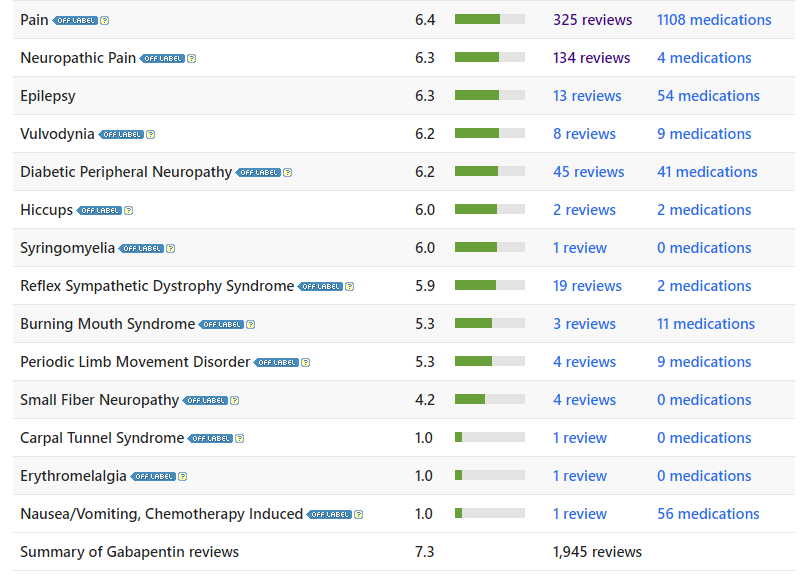
Gabapentin can be used to treat following diseases but only several are on label treatment and almost all of them are off label usages:
-
- Postmenopausal Symptoms
- Alcohol Withdrawal
- Occipital Neuralgia
- Hot Flashes
- Trigeminal Neuralgia
- Bipolar Disorder
- Migraine
- Cough
- Anxiety
- Restless Legs Syndrome
- Postherpetic Neuralgia
- Insomnia
- Pruritus
- Benign Essential Tremor
- Pudendal Neuralgia
- Transverse Myelitis
- Fibromyalgia
- Spondylolisthesis
- Peripheral Neuropathy
- Pain
- Neuropathic Pain
- Epilepsy
- Vulvodynia
- Diabetic Peripheral Neuropathy
- Hiccups
- Syringomyelia
- Reflex Sympathetic Dystrophy Syndrome
- Burning Mouth Syndrome
- Periodic Limb Movement Disorder
- Small Fiber Neuropathy
- Carpal Tunnel Syndrome
What you must know before you take Gabapentin
Before taking gabapentin, tell your doctor or pharmacist if you are allergic to it; or to gabapentin enacarbil; or if you have any other allergies. This product may contain inactive ingredients, which can cause allergic reactions or other problems. Talk to your pharmacist for more details.
Before using this medication, tell your doctor or pharmacist your medical history, especially of: kidney disease, mental/mood problems (such as depression, thoughts of suicide), use/abuse of drugs/alcohol.
This drug may make you dizzy or drowsy or cause blurred vision. Do not drive, use machinery, or do any activity that requires alertness or clear vision until you are sure you can perform such activities safely. Limit alcoholic beverages.
Before having surgery, tell your doctor or dentist about all the products you use (including prescription drugs, nonprescription drugs, and herbal products).
Older adults may be more sensitive to the side effects of this drug, especially swelling of the hands/ankles/feet, dizziness, or loss of coordination. Dizziness and loss of coordination can increase the risk of falling.
Children may be more sensitive to the side effects of this drug, especially mental/mood/behavior changes (such as hostility, problems concentrating, restlessness).
During pregnancy, this medication should be used only when clearly needed. Discuss the risks and benefits with your doctor.
Gabapentin passes into breast milk. Consult your doctor before breast-feeding.
What special precautions should I follow?
Before taking gabapentin,
- tell your doctor and pharmacist if you are allergic to gabapentin, any other medications, or any of the inactive ingredients in the type of gabapentin you plan to take. Ask your pharmacist for a list of the inactive ingredients.
- you should know that gabapentin is available in different forms that may be prescribed for different uses. Ask your doctor to be sure that you are not taking more than one product that contains gabapentin.
- tell your doctor and pharmacist what prescription and nonprescription medications, vitamins, nutritional supplements, and herbal products you are taking or plan to take. Be sure to mention any of the following: hydrocodone (in Hydrocet, in Vicodin, others), medications that make you feel dizzy or drowsy, morphine (Avinza, Kadian, MSIR, others), and naproxen (Aleve, Anaprox, Naprosyn, others). Your doctor may need to change the doses of your medications or monitor you carefully for side effects.
- if you are taking antacids such as Maalox or Mylanta, take them at least 2 hours before you take gabapentin tablets, capsules, or solution.
- tell your doctor if you have or have ever had kidney disease. If you will be taking the extended-release tablets, also tell your doctor if you need to sleep during the day and stay awake at night.
- tell your doctor if you are pregnant, plan to become pregnant, or are breast-feeding. If you become pregnant while taking gabapentin, call your doctor.
- if you are having surgery, including dental surgery, tell the doctor or dentist that you are taking gabapentin.
- you should know that this medication may make you drowsy or dizzy, may slow your thinking, and may cause loss of coordination. Do not drive a car or operate machinery until you know how this medication affects you, and your doctor agrees that it is safe for you to begin these activities.
- if you are giving gabapentin to your child, you should know that your child’s behavior and mental abilities may change while he or she is taking gabapentin. Your child may have sudden changes in mood, become hostile or hyperactive, have difficulty concentrating or paying attention, or be drowsy or clumsy. Have your child avoid activities that could be dangerous, such as riding a bicycle, until you know how gabapentin affects him or her.
- remember that alcohol can add to the drowsiness caused by this medication.
- you should know that your mental health may change in unexpected ways and you may become suicidal (thinking about harming or killing yourself or planning or trying to do so) while you are taking gabapentin for the treatment of epilepsy, mental illness, or other conditions. A small number of adults and children 5 years of age and older (about 1 in 500 people) who took anticonvulsants such as gabapentin to treat various conditions during clinical studies became suicidal during their treatment. Some of these people developed suicidal thoughts and behavior as early as one week after they started taking the medication. There is a risk that you may experience changes in your mental health if you take an anticonvulsant medication such as gabapentin, but there may also be a risk that you will experience changes in your mental health if your condition is not treated. You and your doctor will decide whether the risks of taking an anticonvulsant medication are greater than the risks of not taking the medication. You, your family, or your caregiver should call your doctor right away if you experience any of the following symptoms: panic attacks; agitation or restlessness; new or worsening irritability, anxiety, or depression; acting on dangerous impulses; difficulty falling or staying asleep; aggressive, angry, or violent behavior; mania (frenzied, abnormally excited mood); talking or thinking about wanting to hurt yourself or end your life; withdrawing from friends and family; preoccupation with death and dying; giving away prized possessions; or any other unusual changes in behavior or mood. Be sure that your family or caregiver knows which symptoms may be serious so they can call the doctor if you are unable to seek treatment on your own.
- New Customers Must Know
- 2021 Exempt Prescription Products List Contains Fioricet Generic
- Fioricet Manufactures and Fioricet Pictures
- Estradiol
- Fioricet overdose treatment
- Tips of taking Fioricet
- Downside of taking Foricet
- Esgic Precautions
- Esgic Drug Interactions
- Esgic Description and Brand Names
- What is the side effects of Esgic ?
- How is Esgic Tablets Supplied
- Esgic Over-dosage and Treatment
- Esgic Abuse and Dependence
- Esgic Adverse Reactions
- Gabapentin is the best substitute Prescription of tramadol
- Fioricet Storage and Fioricet Interactions
- What you should know before you buy Fioricet Online ?
- What is narcotic analgesic apap caffeine butalbital oral ?
- Fioricet Side Effects
- The Mechanism of Action of Fioricet
- Fioricet Cautions and Warnings and What You Must Know Before You Ordering Fioricet Online
- What kind of patients are not allowed to buy Gabapentin Online
- What is the most important information I should know about gabapentin (Neurontin)?
- Gabapentin dosing information

